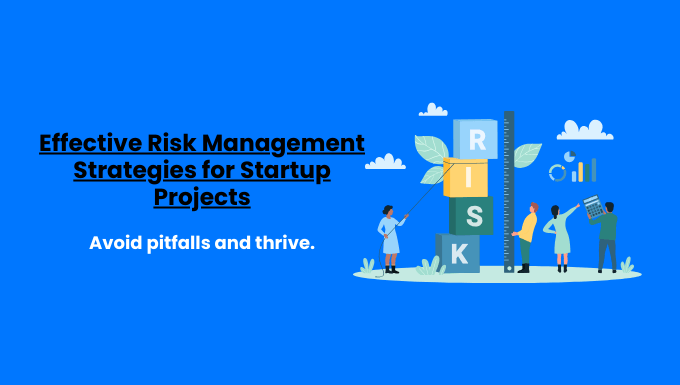Are project management challenges threatening to derail your business goals?
You’re not alone.
Many entrepreneurs face common project management problems that hinder success.
But there’s good news!
You can solve these project management issues with practical solutions.
Whether you’re a startup founder overseeing your first major initiative or an experienced manager looking to refine your skills, understanding and addressing these common project management challenges is crucial.
Key Takeaways:
- Tackle Scope Creep: Define clear project boundaries to prevent uncontrolled changes that derail timelines.
- Enhance Communication: Establish open channels to avoid misunderstandings and keep the team aligned.
- Set Clear Goals: Outline specific objectives so everyone knows what success looks like.
- Manage Budget Constraints: Create detailed budgets and monitor expenses to stay on track financially.
- Bridge Skill Gaps: Assess team skills and provide training to improve performance.
- Prioritize Risk Management: Identify potential risks early and plan strategies to mitigate them.
- Set Realistic Deadlines: Base timelines on actual capacity to prevent burnout and delays.
- Foster Accountability: Assign clear responsibilities to ensure tasks are completed effectively.
- Engage Stakeholders: Communicate regularly with stakeholders to align expectations and gain support.
- Optimize Resource Allocation: Distribute resources efficiently to prevent bottlenecks and maximize productivity.

Contents
Toggle10 Common Project Management Challenges
1. Scope Creep
What is Scope Creep?
Scope creep is the uncontrolled expansion of a project’s scope without corresponding adjustments to time, budget, or resources.
It occurs when additional tasks or requirements are added beyond the initial plan, leading to delays, cost overruns, and resource strain.
It’s like setting out to build a cozy cabin and ending up with plans for a mansion without the extra time, money, or workers to make it happen.
The Impact of Scope Creep
Scope creep can have devastating effects on your project:
- Delays that push deadlines further and further back.
- Ballooning costs that blow your budget out of the water.
- Overworked team members struggling to keep up with expanding demands.
- Reduced quality as resources are stretched thin.
- In worst-case scenarios, complete project failure.!
Solutions to Combat Scope Creep
- Define Clear Project Boundaries:
- Create a detailed project scope document that outlines exactly what is (and isn’t) included in the project.
- Get stakeholder approval on the scope before the project kicks off.
- Use a project roadmap to visualize the project’s boundaries and milestones.
- Implement Change Control Processes:
- Establish a formal procedure for handling change requests.
- Assess the impact of proposed changes on budget, timeline, and resources before approval.
- Use project management software to track and document all change requests.
- Maintain Ongoing Stakeholder Communication:
- Schedule regular check-ins to manage expectations and discuss any potential scope changes.
- Use project management tools to keep stakeholders informed of project progress and any scope-related issues.
By implementing these strategies and learning from real-world successes, you can keep scope creep at bay and guide your projects to successful completion.
Remember, a well-defined scope is the foundation of project success, guard it carefully!
2. Lack of Communication
The Communication Conundrum?
In project management, the communication conundrum refers to the challenges arising from poor communication.
Misunderstood messages and unclear intentions can cause projects to deviate from their intended course, leading to delays, confusion, and misalignment among team members.
The Impact of Communication Breakdown
The consequences of inadequate communication can be severe:
- Project delays as team members work with outdated or incorrect information.
- Conflicts arising from misunderstandings and unclear expectations.
- Reduced team morale due to frustration and confusion.
- Compromised quality as crucial details are lost in translation.
- Missed opportunities for innovation and problem-solving.
A report by PMI found that 29% of project failures were due to poor communication.
Solutions to Boost Project Communication
- Establish Clear Communication Channels:
- Utilize dedicated project management and collaboration tools like Slack, Microsoft Teams, or Asana.
- Define preferred communication methods for different types of information (e.g., email for formal approvals, chat for quick questions).
- Create a communication plan that outlines who needs to be informed about what and when.
- Schedule Regular Meetings:
- Implement daily stand-ups or weekly update meetings to keep everyone aligned.
- Use the Agile methodology for more flexible and frequent communication touchpoints.
- Encourage open dialogue and feedback during these meetings.
- Use Collaboration Tools Effectively:
- Leverage features like contextual comments, @mentions, and task assignments for clear, actionable communication.
- Centralize project documentation in a shared space for easy access.
- Use visual tools like Gantt charts or Kanban boards to communicate project status at a glance.
- Foster a Culture of Open Communication:
- Encourage team members to ask questions and voice concerns without fear of repercussion.
- Lead by example, and be transparent about project challenges and decisions.
- Recognize and reward effective communication within the team.
By implementing these communication strategies and learning from real-world successes, you can transform your project’s communication from a weakness into a strength.
Remember, in project management, silence isn’t golden, clear, consistent communication is the key to success!
3. Lack of Clear Goals and Objectives
The Goal-Setting Dilemma
The goal-setting dilemma occurs when project goals and objectives are vague or undefined.
Managing a project without clear targets can leave the team directionless, struggling to understand what success entails or how to reach it, ultimately jeopardizing project outcomes.
The Impact of Unclear Objectives
The consequences of poorly defined goals can be far-reaching:
- Inefficiencies as team members work towards different or unclear ends.
- Missed deadlines due to lack of clear direction and prioritization.
- Difficulty in measuring success or project progress.
- Reduced team motivation and engagement.
- Increased risk of project failure or underwhelming results.
A study by Gallup found that only 50% of employees strongly agree that they know what’s expected of them at work.
In project management, this lack of clarity can be catastrophic.
Solutions to Set and Maintain Clear Goals
- Set SMART Goals:
- Specific: Clearly define what needs to be accomplished.
- Measurable: Establish concrete criteria for measuring progress.
- Achievable: Ensure goals are realistic given available resources.
- Relevant: Align goals with broader business objectives.
- Time-bound: Set specific deadlines for goal completion.
- Ensure Team Understanding:
- Communicate goals clearly to all team members at the project’s outset.
- Document goals and make them easily accessible to the entire team.
- Use visual aids like goal trees or mind maps to illustrate how individual tasks contribute to overarching objectives.
- Regularly Review Progress:
- Use milestones to track progress toward goals.
- Implement quality tests to ensure objectives are being met to the required standard.
- Schedule regular goal review sessions to assess progress and make adjustments as needed.
- Align Goals with Project Management Methodology:
- Consider using Agile project management for more flexible goal-setting in dynamic environments.
- For more predictable projects, traditional Waterfall methods might be more suitable for establishing clear, long-term goals.
By setting and maintaining clear goals and objectives, you provide your team with a roadmap to success.
Remember, in the world of project management, clarity is king, make sure your goals are as clear as day!
4. Budget Constraints
What is Budget Constraints?
Budget constraints refer to the limitations imposed by a fixed amount of financial resources allocated for a project.
These constraints can restrict project scope, quality, or timelines, challenging project managers to deliver within the set budget while meeting objectives.
Impact of Budget Constraints
- Incomplete projects or reduced scope.
- Compromised quality of deliverables.
- Financial strain on the organization.
- Decreased team morale and stakeholder satisfaction.
Solutions to Overcome Budget Constraints
- Create Detailed Budgets:
- Outline all expected costs and allocate funds accordingly.
- Use project management tools to create comprehensive budget plans.
- Monitor Expenses Regularly:
- Implement real-time expense tracking.
- Use budgeting tools integrated with project management software.
- Conduct weekly or bi-weekly budget reviews.
- Implement Cost-Saving Measures:
- Identify areas to reduce costs without compromising quality.
- Consider outsourcing non-core tasks to reduce overhead.
- Optimize resource allocation to maximize efficiency.
- Plan for Contingencies:
- Allocate 5-10% of the total budget for unexpected expenses.
- Prioritize tasks to ensure critical elements are completed within budget.
- Leverage Value-Based Pricing: If applicable, consider value-based pricing strategies to justify higher budgets for high-value projects
By addressing budget constraints head-on with these strategies, project managers can ensure successful project completion while maintaining financial stability.
Remember, effective cost management is crucial for long-term project and business success.
5. Inadequate Skills of Team Members (Skill Gaps)
What is Skil Gaps?
In project management, skill gaps arise when team members lack the necessary expertise for the tasks at hand.
These gaps can hinder project progress and quality, making it essential for project managers to identify and address them through training or reassignment to ensure success.
According to a report by McKinsey, 87% of companies are experiencing skill gaps or expect to within a few years (McKinsey, 2020).
Impact of Skill Gaps
- Increased errors and quality issues.
- Project delays and missed deadlines.
- Diminished team performance and productivity.
- Increased stress on skilled team members.
- Potential budget overruns due to rework or extended timelines.
Solutions to Address Skill Gaps
- Assess Team Skills:
- Conduct comprehensive skill assessments at the project’s outset.
- Use tools like skill matrices or competency frameworks.
- Identify both technical and soft skill gaps.
- Provide Training and Development:
- Offer targeted training programs to bridge identified skill gaps.
- Utilize a mix of in-house training, online courses, and workshops.
- Implement effective employee training strategies to overcome common challenges.
- Hire or Outsource Expertise:
- Bring in additional expertise for specialized tasks.
- Consider temporary hires or contractors for short-term needs.
- Explore outsourcing options for non-core tasks.
- Foster a Learning Environment:
- Encourage continuous learning and skill enhancement within the team.
- Implement mentorship programs or peer-to-peer learning initiatives.
- Allocate time and resources for self-directed learning.
- Leverage Project Management Tools:
- Use AI project management tools to automate routine tasks.
- Implement collaboration tools to facilitate knowledge sharing.
By proactively addressing skill gaps, project managers can significantly improve project outcomes and team performance.
Remember, investing in your team’s skills is an investment in your project’s success and your organization’s future.
6. Risk Management
What is Risk Management?
Risk management involves identifying, assessing, and mitigating potential risks that could impact a project’s success.
Although essential, it poses a challenge for many project managers who must anticipate uncertainties and develop strategies to minimize their effects on project outcomes.
Impact of Poor Risk Management
- Unexpected setbacks and project delays.
- Increased costs and budget overruns.
- Compromised project quality.
- Potential project failure.
- Damage to organizational reputation.
Solutions for Effective Risk Management
- Conduct Thorough Risk Assessments:
- Identify potential risks early in the project lifecycle.
- Use techniques like SWOT analysis, brainstorming, and expert interviews.
- Categorize risks (e.g., technical, financial, operational).
- Develop Mitigation Strategies:
- Create contingency plans for high-impact risks.
- Use the SMART framework for risk response planning.
- Assign Risk Owners:
- Designate team members responsible for monitoring specific risks.
- Ensure clear communication channels for risk escalation.
- Continuously Monitor Risks:
- Regularly review and update the risk management plan.
- Use project management software with risk-tracking features.
- Conduct periodic risk reassessments as the project progresses.
- Leverage AI for Risk Management:
- Implement AI-powered risk management tools for early detection and analysis.
- Use predictive analytics to forecast potential risks.
Risk Management Framework
| Risk Management Phase | Key Activities | Tools and Techniques |
| Risk Identification | Brainstorming, historical review, SWOT analysis | Risk breakdown structure, risk register |
| Risk Assessment | Qualitative and quantitative analysis | Probability and impact matrix, Monte Carlo simulation |
| Risk Response Planning | Develop strategies: avoid, transfer, mitigate, accept | Decision trees, cost-benefit analysis |
| Risk Monitoring and Control | Track identified risks, identify new risks | Risk audits, variance analysis, trend analysis |
By implementing robust risk management strategies, project managers can significantly increase the likelihood of project success.
Remember, effective risk management is not about avoiding all risks, but about identifying, assessing, and managing them proactively.
7. Unrealistic Deadlines
What is Unrealistic Deadlines?
Unrealistic deadlines in project management occur when timelines are set without considering the project’s complexity or resource availability.
These deadlines can cause stress, burnout, and lower project quality as teams struggle to meet the demands within the limited time frame.
Impact of Unrealistic Deadlines
- Increased stress and potential burnout among team members.
- Reduced work quality due to rushed completion.
- Missed deadlines and project delays.
- Decreased team morale and job satisfaction.
- Potential loss of client trust or business reputation.
Solutions for Managing Unrealistic Deadlines
- Set Realistic Timelines:
- Base deadlines on project requirements and team capacity.
- Use historical data and expert judgment to estimate task durations.
- Implement time blocking strategies for efficient time management.
- Negotiate Deadlines:
- Communicate openly with stakeholders about realistic timeframes.
- Present data-driven arguments for extending deadlines when necessary.
- Offer alternative solutions, such as phased deliveries or MVP (Minimum Viable Product) approaches.
- Prioritize Tasks:
- Use techniques like MoSCoW (Must have, Should have, Could have, Won’t have) for task prioritization.
- Focus on critical tasks and allow buffer time for unforeseen delays.
- Implement agile methodologies for flexibility in task management.
- Use Project Management Tools:
- Implement tools like Gantt charts to visualize timelines and dependencies.
- Utilize AI-powered project management software for accurate time estimation and resource allocation.
- Improve Team Productivity:
- Identify and eliminate time-wasting activities.
- Implement productivity techniques like the Pomodoro method.
- Encourage work-life balance to prevent burnout and maintain long-term productivity.
Deadline Management Techniques
| Technique | Description | Benefits |
| Critical Path Method (CPM) | Identify the longest sequence of dependent tasks | Focuses on crucial tasks that directly impact the project timeline |
| PERT (Program Evaluation and Review Technique) | Uses optimistic, pessimistic, and most likely time estimates | Provides a more realistic view of project duration |
| Buffer Management | Add time buffers to high-risk or complex tasks | Helps absorb unexpected delays without impacting the overall timeline |
| Sprint Planning | Break the project into short, manageable sprints | Allows for regular reassessment and adjustment of timelines |
By implementing these strategies, project managers can effectively manage deadlines, improve project outcomes, and maintain team morale.
Remember, the goal is not just to meet deadlines, but to deliver quality results that meet stakeholder expectations.
8. Lack of Accountability
What is Lack of Accountability?
A lack of accountability in project management occurs when team members are not held responsible for their tasks.
This issue can lead to inconsistency, missed deadlines, subpar work quality, and reduced team morale, ultimately jeopardizing the project’s success.
Impact
- Missed deadlines: Without clear accountability, tasks may slip through the cracks, leading to project delays.
- Subpar work: Team members who aren’t held responsible for their output may not put forth their best effort.
- Diminished team morale: When some team members consistently fall short without consequences, it can frustrate and demotivate others.
Solutions
- Define Clear Roles and Responsibilities:
- Assign specific tasks and ownership to each team member.
- Use a RACI (Responsible, Accountable, Consulted, Informed) matrix to clarify roles.
- Use Project Management Tools:
- Foster a Culture of Accountability:
- Encourage regular check-ins and provide constructive feedback.
- Implement a system of peer reviews to promote shared responsibility.
- Recognize and Reward Accountability:
- Acknowledge team members who consistently meet their responsibilities.
- Consider implementing a performance-based reward system.
In summary, addressing the lack of accountability is essential for project success.
By defining clear roles, using management tools, fostering a culture of responsibility, and recognizing achievements, project managers can mitigate the negative effects and ensure a more cohesive and productive team environment.
9. Stakeholder Engagement
What is Stakeholder Engagement?
Stakeholder engagement involves identifying, engaging, and managing the interests and expectations of all parties involved in a project.
Effective engagement ensures aligned objectives and minimizes conflicts, contributing to the project’s success.
Impact
- Misaligned expectations: Stakeholders may have different ideas about project outcomes, leading to dissatisfaction.
- Increased conflicts: Poor communication can result in disagreements and roadblocks.
- Potential project failure: Lack of stakeholder support can derail even the most well-planned projects.
Solutions
- Identify and Prioritize Stakeholders:
- Determine who needs to be engaged and to what extent.
- Use a stakeholder mapping tool to visualize influence and interest levels.
- Develop a Stakeholder Engagement Plan:
- Outline strategies for regular communication and involvement.
- Tailor communication methods to each stakeholder’s preferences.
- Maintain Regular Communication:
- Keep stakeholders informed through updates, meetings, and reports.
- Use a mix of formal reports and informal check-ins for comprehensive coverage.
- Involve Stakeholders Early and Often:
- Engage stakeholders from the beginning to ensure buy-in and support.
- Seek input at key decision points to maintain alignment.
Effective stakeholder engagement is an ongoing process that requires consistent communication and active involvement.
By prioritizing and managing stakeholder relationships, project leaders can ensure alignment, reduce conflicts, and ultimately drive successful project outcomes.
10. Resource Allocation
What is Resource Allocation?
Resource allocation is the process of efficiently distributing available resources such as personnel, budget, and technology across project tasks.
Proper allocation ensures that resources are used effectively to meet project goals and deadlines, while poor allocation can lead to delays and budget overruns.
Impact
- Resource shortages: Inadequate allocation can lead to bottlenecks and delays.
- Overutilization: Overburdening resources can lead to burnout and quality issues.
- Underutilization: Inefficient use of resources wastes potential and budget.
Solutions
- Use Resource Management Tools:
- Track resource availability and utilization with project management software.
- Implement tools like ClickUp or Microsoft Project for comprehensive resource planning.
- Prioritize Tasks Based on Resources:
- Allocate resources to high-priority tasks first.
- Use techniques like the MoSCoW method (Must have, Should have, Could have, Won’t have) for task prioritization.
- Adjust Allocations as Project Needs Evolve:
- Be flexible in reallocating resources based on project progression.
- Conduct regular resource reviews to ensure optimal allocation.
- Optimize Resource Use:
- Avoid overallocation by balancing workloads and adjusting timelines if necessary.
- Consider cross-training team members to increase flexibility in resource allocation.
Successful resource allocation requires continuous monitoring and flexibility.
By using the right tools and strategies, project managers can optimize resources, prevent bottlenecks, and maintain project momentum, ensuring both efficiency and project success.
Additional Insights on Project Management
Understanding the broader context of project management challenges can provide a valuable perspective.
Let’s look at some project failure statistics and the importance of project management tools.
Project Failure Statistics
The prevalence of project management challenges is reflected in some sobering statistics:
- According to a study by the Project Management Institute, 11.4% of investment is wasted due to poor project performance.
- The Standish Group’s CHAOS report found that only 29% of software projects are successful, with 19% considered utter failures.
- Harvard Business Review reports that one in six IT projects has an average cost overrun of 200% and a schedule overrun of 70%.
These statistics underscore the importance of effective project management and the need to address common challenges proactively.
Importance of Project Management Tools
In today’s digital age, leveraging the right project management tools can significantly mitigate many of the challenges we’ve discussed.
These tools streamline workflows, enhance communication, and provide valuable insights for better decision-making.
Here’s why they’re crucial:
- Centralize Communication and Collaboration:
- Tools like Slack or Microsoft Teams integrate with project management software to keep all project-related communication in one place.
- This reduces the risk of miscommunication and ensures everyone has access to the latest information.
- Enhance Transparency and Accountability:
- Facilitate Real-time Tracking and Reporting:
- Tools such as Jira or Monday.com offer real-time dashboards and reporting features.
- This allows project managers to stay on top of project progress and make data-driven decisions.
By leveraging these tools, project managers can address many of the common challenges we’ve discussed, from communication issues to resource allocation problems.
By addressing these challenges head-on, you’re not just solving problems, you’re building a foundation for project success.
Whether you’re a seasoned project manager or just starting out, these insights can help you navigate the complexities of project management with confidence.
People Also Asked
1. What is scope creep and how can it be prevented?
Scope creep is the uncontrolled expansion of a project’s scope without adjusting time, resources, or budget.
To prevent it, clearly define project boundaries upfront, implement a formal change control process, and maintain ongoing communication with stakeholders.
2. How can poor communication impact a project, and what are some solutions?
Poor communication can lead to misunderstandings, missed deadlines, and reduced team morale.
Solutions include establishing clear communication channels, scheduling regular meetings, and using collaboration tools effectively.
3. What are the impacts of skill gaps within a project team, and how can they be addressed?
Skill gaps in a project team can lead to increased errors, delays, and reduced performance.
Address them by conducting skill assessments, offering targeted training, and outsourcing specialized tasks to ensure project efficiency and quality.
4. Why is risk management crucial in project management?
Risk management is crucial because it helps identify and mitigate potential issues that could derail a project.
Effective risk management involves conducting thorough risk assessments, developing mitigation strategies, and continuously monitoring risks throughout the project lifecycle.
5. What are the consequences of setting unrealistic deadlines?
Setting unrealistic deadlines can lead to stress, burnout, reduced work quality, and missed milestones.
To avoid this, base timelines on project requirements and team capacity, negotiate deadlines when necessary, and use project management tools to visualize timelines.






